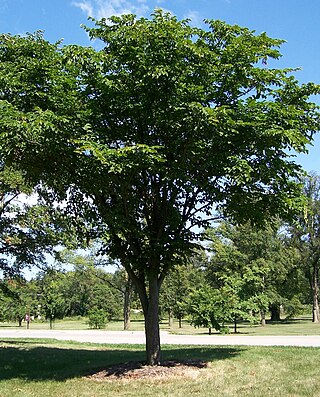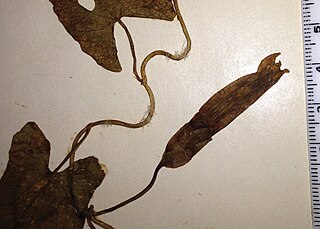Related Research Articles

Melicope is a genus of about 240 species of shrubs and trees in the family Rutaceae, occurring from the Hawaiian Islands across the Pacific Ocean to tropical Asia, Australia and New Zealand. Plants in the genus Melicope have simple or trifoliate leaves arranged in opposite pairs, flowers arranged in panicles, with four sepals, four petals and four or eight stamens and fruit composed of up to four follicles.

Magnolia denudata, the lilytree or Yulan magnolia, is native to central and eastern China. It has been cultivated in Chinese Buddhist temple gardens since 600 AD. Its flowers were regarded as a symbol of purity in the Tang Dynasty and it was planted in the grounds of the Emperor's palace. It is the official city flower of Shanghai.

The Arnold Arboretum of Harvard University is a botanical research institution and free public park, located in the Jamaica Plain and Roslindale neighborhoods of Boston, Massachusetts. Established in 1872, it is the oldest public arboretum in North America. The landscape was designed by Charles Sprague Sargent and Frederick Law Olmsted and is the second largest "link" in the Emerald Necklace. The Arnold Arboretum's collection of temperate trees, shrubs, and vines has an emphasis on the plants of the eastern United States and eastern Asia, where arboretum staff and colleagues are sourcing new material on plant collecting expeditions. The arboretum supports research in its landscape and in its Weld Hill Research Building.

Tiarella, the foamflowers, is a genus of flowering plants in the family Saxifragaceae. The generic name Tiarella means "little turban", which suggests the shape of the seed capsules. Worldwide there are seven species, one each in eastern Asia and western North America, plus five species in eastern North America. As of October 2022, the taxonomy of Tiarella in eastern North America is in flux.

Elmer Drew Merrill was an American botanist and taxonomist. He spent more than twenty years in the Philippines where he became a recognized authority on the flora of the Asia-Pacific region. Through the course of his career he authored nearly 500 publications, described approximately 3,000 new plant species, and amassed over one million herbarium specimens. In addition to his scientific work he was an accomplished administrator, college dean, university professor and editor of scientific journals.

The Harvard University Herbaria and Botanical Museum are institutions located on the grounds of Harvard University at 22 Divinity Avenue, Cambridge, Massachusetts. The Botanical Museum is one of three which comprise the Harvard Museum of Natural History.

Ulmus laciniata var. nikkoensisRehder, the Nikko elm, was discovered as a seedling near Lake Chūzenji, near Nikkō, Japan, and obtained by the Arnold Arboretum in 1905. The taxonomy of the tree remains a matter of contention, and has been considered possibly a hybrid of U. laciniata and U. davidiana var. japonica. However, in crossability experiments at the Arnold Arboretum in the 1970s, U. laciniata, a protogynous species, was found to be incompatible with U. davidiana var. japonica, which is protandrous.
Leonard John Brass was an Australian and American botanist, botanical collector and explorer.
Thomas Gordon Hartley was an American botanist.

Parsonsia is a genus of woody vines in the family Apocynaceae. Species occur throughout Indomalaya, Australasia and Melanesia.
Harvard Papers in Botany is a peer-reviewed scientific journal published twice a year, in June and December. It covers all aspects of plants and fungi including longer monographs, floristics, economic botany, and the history of botany.
The Seed Herbarium Image Project (SHIP), is an initiative of the Arnold Arboretum of Harvard University to create a web-based repository of high-resolution digital images documenting the morphology of woody plant seeds and selected fruit structures. Headquartered at the Arboretum’s Dana Greenhouse facility and coordinated and photographed by curatorial assistant Julie McIntosh Shapiro, the Seed Herbarium Image Project supports the work of educators and professionals in horticulture and the botanical sciences, particularly in conservation research and management of rare and endangered species. The digitized images of seeds offer an important new aid for teaching seed identification—a fundamental skill in plant propagation, hybridization, and distribution—and serve as a resource for nurserymen, horticulturists, botanical curators, taxonomists, ecologists, and the general public. SHIP also provides an online resource for botanical institutions and nurseries to verify their collections and inventories. SHIP is made possible through the generous support of the Stanley Smith Horticultural Trust, Cabot Family Charitable Trust, and the J. Frank Schmidt Family Charitable Foundation.

Mary Katharine "Kate" Brandegee was an American botanist known for her comprehensive studies of flora in California.

Caroline Priscilla Bingham was an American botanist who was one of the earliest American women to publish scientific papers on botany. She was an influential collector of botanical specimens discovering a new genus and several new species. As a result of her discoveries Bingham had a genus and several algae species named in her honor.

Bernice Giduz Schubert was an American botanist. Her academic career developed over 53 years as a professor and herbarium curator with Harvard University.

Carex bebbii, Bebb's sedge, is a species of sedge native to the northern United States and Canada. Carex bebbii grows in a variety of wetland habitats such as lakeshores, streambanks, ditches, meadows, swamps, and seeps. It forms dense tufts with culms up to 90 centimeters tall.

Delzie Demaree was an American botanist, and plant collector. His place of death is reported as Bonham, Arkansas or Texas.
Perryodendron is a monotypic genus of flowering plants belonging to the family Rutaceae. The only known species is Perryodendron parviflorum.

Emma Jane Cole was an American teacher, botanist, and curator, and the author of Grand Rapids Flora: A Catalogue of the Flowering Plants and Ferns Growing Without Cultivation in the Vicinity of Grand Rapids, Michigan. She was inducted into the Michigan Women's Hall of Fame in 2007.

Syzygium tierneyanum, commonly known as river cherry, water cherry, or Bamaga satinash, is a tree in the family Myrtaceae which is native to New Guinea, the Solomon Islands, Vanuatu and north east Queensland. It often grows along watercourses where it is a facultative rheophyte.
References
- ↑ Lindon, Heather L.; Gardiner, Lauren M.; Brady, Abigail; Vorontsova, Maria S. (5 May 2015). "Fewer than three percent of land plant species named by women: Author gender over 260 years". Taxon. 64 (2): 209–215. doi:10.12705/642.4.
- 1 2 3 4 Howard, Richard A. (1992). "Lily May Perry (1895-1992)". Taxon. 41 (4): 792–796. JSTOR 1222424.
- ↑ Stafleu, Frans Antonie.; Cowan, Richard (1983). Taxonomic literature : a selective guide to botanical publications and collections with dates, commentaries and types (TL2). Utrecht: Bohn, Scheltema & Holkema. pp. 177–8. ISBN 9789031302246 . Retrieved 22 March 2014.
- ↑ "Botany Libraries Harvard University Herbaria Economic Botany Archives Richard Evans Schultes". botlib.huh.harvard.edu. Archived from the original on 2019-06-20. Retrieved 2019-02-09.
- ↑ International Plant Names Index. L.M.Perry.
- ↑ "Perryodendron T.G.Hartley | Plants of the World Online | Kew Science". Plants of the World Online. Retrieved 26 September 2021.